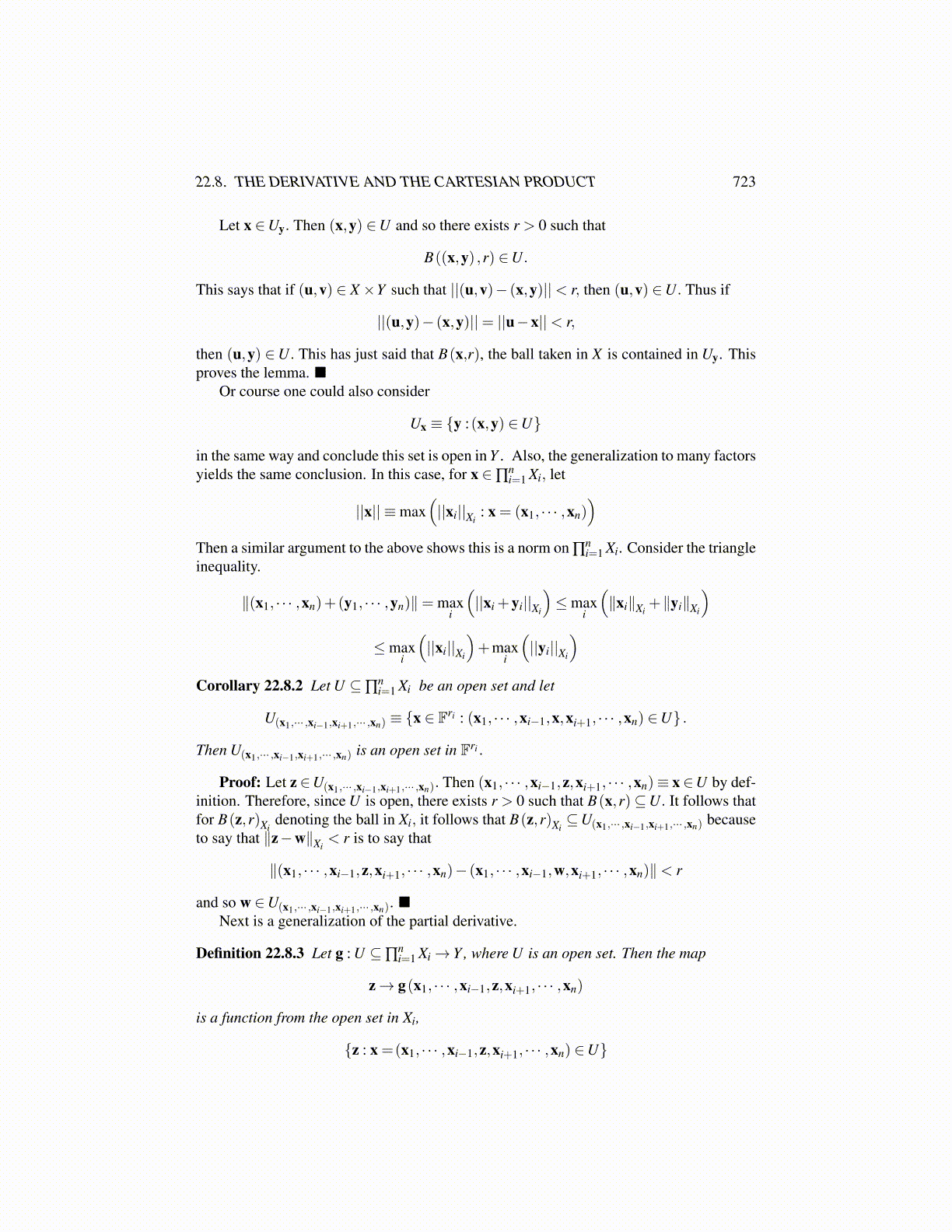
22.8. THE DERIVATIVE AND THE CARTESIAN PRODUCT 723
Let x ∈Uy. Then (x,y) ∈U and so there exists r > 0 such that
B((x,y) ,r) ∈U.
This says that if (u,v) ∈ X×Y such that ||(u,v)− (x,y)||< r, then (u,v) ∈U. Thus if
||(u,y)− (x,y)||= ||u−x||< r,
then (u,y) ∈U. This has just said that B(x,r), the ball taken in X is contained in Uy. Thisproves the lemma.
Or course one could also consider
Ux ≡ {y :(x,y) ∈U}
in the same way and conclude this set is open in Y . Also, the generalization to many factorsyields the same conclusion. In this case, for x ∈∏
ni=1 Xi, let
||x|| ≡max(||xi||Xi
: x = (x1, · · · ,xn))
Then a similar argument to the above shows this is a norm on ∏ni=1 Xi. Consider the triangle
inequality.
∥(x1, · · · ,xn)+(y1, · · · ,yn)∥= maxi
(||xi +yi||Xi
)≤max
i
(∥xi∥Xi
+∥yi∥Xi
)≤max
i
(||xi||Xi
)+max
i
(||yi||Xi
)Corollary 22.8.2 Let U ⊆∏
ni=1 Xi be an open set and let
U(x1,··· ,xi−1,xi+1,··· ,xn) ≡ {x ∈ Fri : (x1, · · · ,xi−1,x,xi+1, · · · ,xn) ∈U} .
Then U(x1,··· ,xi−1,xi+1,··· ,xn) is an open set in Fri .
Proof: Let z ∈U(x1,··· ,xi−1,xi+1,··· ,xn). Then (x1, · · · ,xi−1,z,xi+1, · · · ,xn)≡ x ∈U by def-inition. Therefore, since U is open, there exists r > 0 such that B(x,r)⊆U. It follows thatfor B(z,r)Xi
denoting the ball in Xi, it follows that B(z,r)Xi⊆U(x1,··· ,xi−1,xi+1,··· ,xn) because
to say that ∥z−w∥Xi< r is to say that
∥(x1, · · · ,xi−1,z,xi+1, · · · ,xn)− (x1, · · · ,xi−1,w,xi+1, · · · ,xn)∥< r
and so w ∈U(x1,··· ,xi−1,xi+1,··· ,xn).Next is a generalization of the partial derivative.
Definition 22.8.3 Let g : U ⊆∏ni=1 Xi→ Y , where U is an open set. Then the map
z→ g(x1, · · · ,xi−1,z,xi+1, · · · ,xn)
is a function from the open set in Xi,
{z : x =(x1, · · · ,xi−1,z,xi+1, · · · ,xn) ∈U}